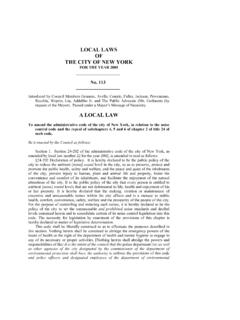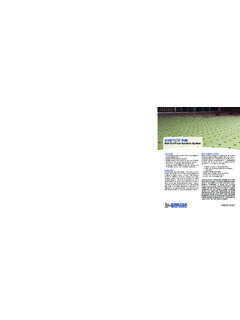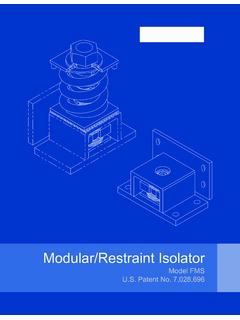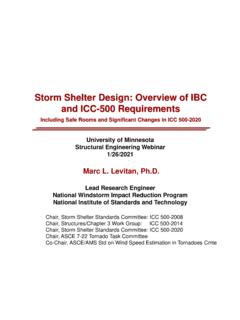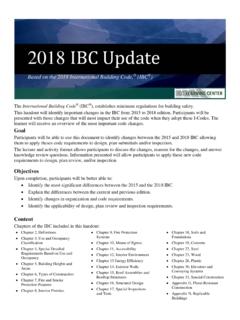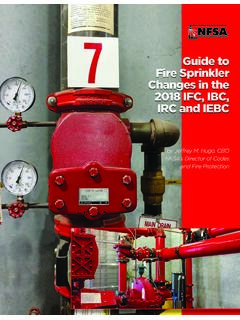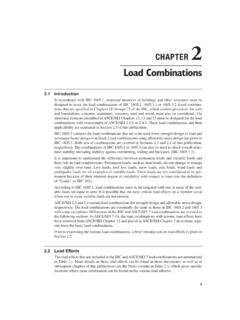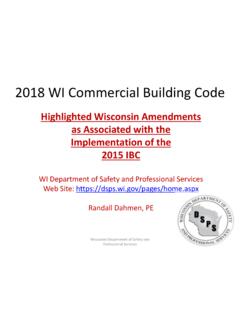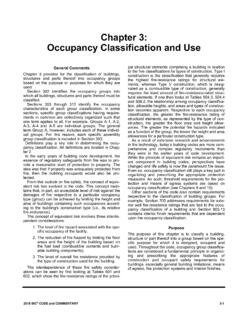Transcription of KINETICS™ Guide to Understanding IBC Seismic for MEP
1 KINETICS Guide to Understanding IBC Seismic for MEP. TABLE OF CONTENTS. Section Title Introduction Required Basic Project Information Introduction building Use Nature of Occupancy Site Class Mapped Acceleration Parameters Seismic Design Category Summary Component Importance Factor Introduction Criteria for Assigning a Component Importance Factor Summary General Exemptions and Requirements Introduction Exemptions for Seismic Design Categories A and B. Exemptions for Seismic Design Category C. Exemptions for Seismic Design Categories D, E, and F. Chandelier Exemption Component Size Relative to the building Structure Reference Documents Allowable Stress Design Submittals and Construction Documents Equipment Certification for Essential Facilities Consequential or Collateral Damage Flexibility of Components and Their Supports and Restraints Summary TABLE OF CONTENTS.
2 PAGE 1 of 3 Toll Free (USA Only): 800-959-1229 RELEASED ON: 05/29/2008. international : 614-889-0480. FAX 614-889-0540. World Wide Web: E-mail: Dublin, Ohio, USA Mississauga, Ontario, Canada Member KINETICS Guide to Understanding IBC Seismic for MEP. Section Title Exemptions for Piping Systems Introduction The 12 Rule Single Clevis Supported Pipe in Seismic Design Categories A and B. Single Clevis Supported Pipe in Seismic Design Category C. Single Clevis Supported Pipe in Seismic Design Categories D, E, and F. Exemptions for Trapeze Supported Pipe per VISCMA Recommendations Trapeze Supported Pipe in Seismic Design Categories A and B. Trapeze Supported Pipe in Seismic Design Category C. Trapeze Supported Pipe in Seismic Design Category D.
3 Trapeze Supported Pipe in Seismic Design Categories E and F. Summary Exemptions for HVAC Ductwork Introduction The 12 Rule Size Exemption Further Exemptions for Ductwork Restraint Allowance for In-Line Components Summary Exemptions for Electrical Introduction Implied Blanket Exemption Based on Component Importance Factor Conduit Size Exemptions Trapeze Supported Electrical Distribution Systems Summary Seismic Design Forces Introduction Horizontal Seismic Design Force TABLE OF CONTENTS. PAGE 2 of 3 Toll Free (USA Only): 800-959-1229 RELEASED ON: 05/29/2008. international : 614-889-0480. FAX 614-889-0540. World Wide Web: E-mail: Dublin, Ohio, USA Mississauga, Ontario, Canada Member KINETICS Guide to Understanding IBC Seismic for MEP. Section Title Vertical Seismic Design Force 8.
4 4 The Evolution of a P and R P Factors LRFD versus ASD. Summary Anchorage of MEP Components to the building Structure Introduction General Guidelines for MEP Component Anchorage Anchorage in (Cracked) Concrete and Masonry Undercut Anchors Prying of Bolts and Anchors Power Actuated or Driven Fasteners Friction Clips Summary TABLE OF CONTENTS. PAGE 3 of 3 Toll Free (USA Only): 800-959-1229 RELEASED ON: 05/29/2008. international : 614-889-0480. FAX 614-889-0540. World Wide Web: E-mail: Dublin, Ohio, USA Mississauga, Ontario, Canada Member KINETICS Guide to Understanding IBC Seismic for MEP. INTRODUCTION. The purpose of this manual is to provide design professionals, contractors, and building officials responsible for the MEP, Mechanical, Electrical, and Plumbing, with the information and guidance required to ensure that the Seismic restraints required for a specific project are selected and/or designed, and installed in accordance with the provisions code .
5 This Guide will be written in several easily referenced sections that deal with specific portions of the code . This Guide is based on the international building code (IBC). The 2000 IBC and the 2003 IBC are very similar, and in fact are almost identical. When they are referenced in this manual, it will be as 2000/2003 IBC. The latest version of the IBC that is currently being adopted by the various states is 2006 IBC. This is the version that will form the core basis for this manual. When appropriate the differences between the 2006 IBC and the 2000/2003 IBC will be pointed out. The intent is to have a working Guide that is based on the current 2006 IBC, but is also relevant to the 2000/2003 IBC. The code based requirements for the restraint of pipe and duct are found in the following references.
6 1. 2007 ASHRAE HANDBOOK Heating, Ventilating, and Air-Conditioning Applications;. American Society of Heating, Refrigerating and Air-Conditioning Engineers, Inc., 1791 Tullie Circle, Atlanta, GA 30329, 2007; Chapter 54 Pp 54-11 and 54-12. 2. 2000 international building code ; international code Council, 5203 Leesburg Pike, Suite 708, Falls Church, Virginia, 22041-3401; 2000. 3. ASCE 7-98 Minimum Design Loads for Buildings and Other Structures; American Society of Civil Engineers, 1801 Alexander Bell Drive, Reston, Virginia 20191-4400, Chapter 9. 4. 2003 international building code ; international code Council, Inc., 4051 West Flossmoor Road, Country Club Hills, Illinois 60478-5795; 2002. 5. ASCE/SEI 7-02 Minimum Design Loads for Buildings and Other Structures; American Society of Civil Engineers, 1801 Alexander Bell Drive, Reston, Virginia 20191-4400, Chapter 9.
7 INTRODUCTION. PAGE 1 of 2 Toll Free (USA Only): 800-959-1229 RELEASED ON: 05/06/2008. international : 614-889-0480. FAX 614-889-0540. World Wide Web: E-mail: Dublin, Ohio, USA Mississauga, Ontario, Canada Member KINETICS Guide to Understanding IBC Seismic for MEP. 6. 2006 international building code ; international code Council, Inc., 4051 West Flossmoor Road, Country Club Hills, Illinois 60478-5795; 2006. 7. ASCE/SEI 7-05 Minimum Design Loads for Buildings and Other Structures; American Society of Civil Engineers, 1801 Alexander Bell Drive, Reston, Virginia 20191-4400, Chapters 1, 2, 11, 13, 20, and 21. 8. SMACNA, Seismic Restraint Manual Guidelines for Mechanical Systems with Addendum No. 1 2nd Edition; Sheet Metal and Air Conditioning Contractors' National Association, Inc.
8 , 4201 Lafayette Center Drive, Chantilly, Virginia 20151-1209, 1998. 9. UNIFIED FACILITIES CRITERIA (UFC) Seismic Design for Buildings; United States Department of Defense Document UFC 3-310-03A, 1 March 2005; Table 3-3, Pp 3-13 3- 17. The selection and installation of the proper Seismic restraints for MEP systems requires good coordination with the design professionals and contractors involved with the building project. A. good spirit of cooperation and coordination is especially required for projects that have been designated as essential facilities, such as hospitals, emergency response centers, police and fire stations. Coordination between the various design professionals and contractors will be a constant theme throughout this Guide .
9 This coordination is vital for the following reasons. 1. The Seismic restraints that are installed for a system can and will interfere with those of another unless restraint locations are well coordinated. 2. The space required for the installed restraints can cause problems if non-structural walls need to be penetrated, or other MEP components are in the designed load path for the restraints. 3. The building end of the Seismic restraints must always be attached to structure that is adequate to carry the code mandated design Seismic loads. It is the responsibility of the structural engineer of record to verify this. INTRODUCTION. PAGE 2 of 2 Toll Free (USA Only): 800-959-1229 RELEASED ON: 05/06/2008. international : 614-889-0480. FAX 614-889-0540.
10 World Wide Web: E-mail: Dublin, Ohio, USA Mississauga, Ontario, Canada Member KINETICS Guide to Understanding IBC Seismic for MEP. REQUIRED BASIC PROJECT INFORMATION. Introduction: As with any design job, there is certain basic information that is required before Seismic restraints can be selected and placed. The building owner, architect, and structural engineer make the decisions that form the basis for the information required to select the Seismic restraints for the pipe and duct systems in the building . This is information that should be included in the specification and bid package for the project. It also should appear on the first sheet of the structural drawings. For consistency, it is good practice to echo this information in the specification for each building system, and on the first sheet of the drawings for each system.
